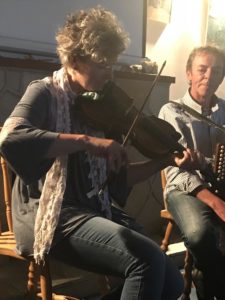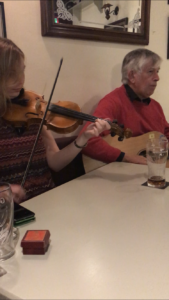I am partway through my second week of classes at Oideas Gael. I have had a more fantastic time than I could have imagined! I became very close with my classmates last week, even though we have only known each other for a few days. I think that the intensity of the classes and our shared interests bonded us together. For that reason, it was sad to say goodbye to many of my new friends last Friday. I am staying in Gleann Cholm Cille for the next three weeks, but many of the students come for just one week. Luckily, I also have many friends from the first week who are staying for at least another week!
Today I have been reflecting on the role of music and singing — ceol agus amhránaíocht — in the Irish language and culture. I took a class on Irish-language song this past semester, which has turned out to be perfect preparation for my time in Gleann Cholm Cille. Music is an integral part of traditional Irish life. Just this past week, I attended a night of singing at Oideas Gael, sang several songs in my classes, heard plenty of Irish-language singing in pubs on various nights, and listened as my classmates in Oideas Gael played the flute, harp, and guitar. Even if you’re like me and can barely sing, songs are a reliable way to pick up vocabulary because you can hear them all the time.

My favorite cultural activity so far has been the night of amhránaíocht at Oideas Gael last Tuesday. One of the teachers printed copies of the lyrics to several Irish-language songs and taught us the pronunciation and meaning of them before beginning to sing. She had a beautiful voice; I think many of us students were too distracted by her voice to join in ourselves! Our teacher told us all about her childhood in a mixture of English and Irish, describing how she learned to sing when she was younger. Every song had a story behind it and a particular association with a person or an event from her childhood. It was very moving to see how happy my teacher became as she sang and recalled these memories. I naturally learned several new words as we sang each song, and experiencing the musical quality of the language firsthand inspired me to continue working hard to increase my language fluency.
I also enjoyed a musical night at the “Rusty Mackerel” pub in a nearby town. The town is located even further into the Irish-speaking Gaeltacht, so most of the people there were speaking Irish with each other. A man and a woman playing the guitar and fiddle, respectively, sat in the corner and entertained everyone with music and Irish-language singing throughout the night. Eventually they opened the mic to anyone who could sing or play an instrument. The man said that anyone was welcome to come up and sing in Irish or in English, so we enjoyed music in both languages!
As I listened to the music, I began talking with an older man who told me about his life in the Gaeltacht. The man told me that he was born in 1934, and that he barely spoke English as a child. His brother didn’t speak English at all. The vast majority of the people in his hometown spoke Irish all of the time. Such experiences are increasingly rare now, since less and less people are growing up speaking Irish as a first language. It must have been very bizarre for this man to see his first language gradually dwindling in the very place where he had grown up speaking it.
Happily, though, the language seems to be very much alive and well out here in the Gaeltacht. People are really passionate about preserving and revitalizing the language for subsequent generations. I have been really inspired by the people in charge of Oideas Gael and their dedication to teaching the language; it is thanks to people like them that non-native Irish speakers can pursue their interest in the language. And it is thanks to the music that several people outside of Ireland have become interested in the language in the first place. Irish students learn at least some basic phrases and grammatical constructions in school, but many non-Irish students I have spoken with first heard the language through music. When they listened to an Irish-language song in a pub or on a CD, they were so moved that they were inspired to research the language and begin learning it.
